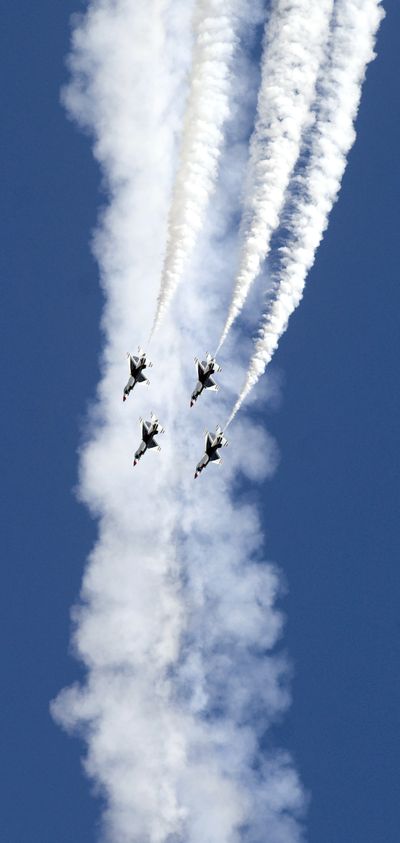Eyes on the sky
Aerobatics thrill fans, pilots alike at Fairchild show

As the woman in red tumbles through the sky in her aerobatic biplane, the smoke trail can barely keep up with the dizzying changes in altitude and rolls of her Pitts Special.
And when she dived and climbed and rolled on Saturday, the terrain below pilot Jacquie “Jacquie Baby” Warda and her plane Red Eagle probably looked familiar. After all, Warda knows Spokane fairly well; she lives in San Francisco, but called Spokane home for 22 years. It’s where she learned to golf, ski and, more importantly, fly a plane, out at Felts Field.
“If I didn’t have an airplane, I would do nothing but want to fly,” the 56-year-old said after her Saturday performance at SkyFest, at Fairchild Air Force Base.
The Red Eagle, too, is acquainted with Spokane. Warda bought the plane from a friend at Felts Field. The plane was originally built to fly around the Statue of Liberty for its 100th birthday, along with the White Eagle and the Blue Eagle.
She calls the Red Eagle a “hangar queen” because to maintain its classic paint job – with red and gold stars and an eagle on the nose – the plane must be stored inside. The Red Eagle has a steel frame, but like classic biplanes the body is constructed with wood and fabric, Warda said.
Warda started flying when she was 32 and performed in her first air show at age 50. As a student pilot, she found regular flying dull.
“After my first roll with a friend in a plane, I was hooked. I knew there was something else to do with an airplane than go straight,” she said.
Other performances of the day included a B-2 flyover, a PT-17 Stearman Kaydet trainer, an F/A-18 Super Hornet, an A-10 Thunderbolt II, the KC-135 Stratotanker, and the F-16 Fighting Falcons piloted by the Air Force’s top performers, the Thunderbirds.
For many of the SkyFest attendees, the Thunderbirds are the draw.
Six Thunderbird planes converged and diverged above the crowd for an hour, at times with as little as a few feet between them. They performed their signature move, the “bomb burst,” where four planes race upward at a speed of around 1,000 miles per hour, then dive in separate directions, releasing a smoke trail. Then a fifth plane races up through the middle of the cloud, creating five trails of smoke that dissipate above the crowd. The Thunderbirds have been performing for 57 years, according to the show emcee.
Reed Roberts had seen the Thunderbirds and SkyFest before Saturday.
“They exemplify what Air Force is all about: keeping peace for America and its allies,” said Roberts, a retired colonel who served twice at Fairchild. He was stationed with a B-52 at the air show in 1980 when Mount St. Helens erupted and the air show was canceled.
Another spectator, from Gig Harbor, has attended air shows since she was young.
“It’s easy to dream you’re up there and you can imagine what it’s like to tumble” said Lisa Lance, whose parents both served in the Air Force.
As temperatures reached the upper 90s, throngs of air show fans huddled in the shade of display planes to try to keep cool. The “Coinforce Cool Zone” trailer – a horse trailer with five misting fans – was quite popular. A retired Air Force couple who live near Joint Base Lewis-McChord bought the small trailer to “bring to military events to take care of soldiers and their families,” said owner Jordan Haines. Throughout the day as many as 40 people stood in front of the mist to cool down.
“When the kids get into the water they’re happy and the parents are more comfortable,” Haines said.